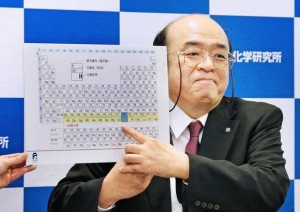A Japanese team has received official credit for the discovery of element 113, making the group the first in Asia to have its accomplishments enshrined in the periodic table. The International Union of Pure and Applied Chemistry certified Thursday that a team led by Kosuke Morita at government-affiliated research institute Riken discovered the element. The group first managed to synthesize it in July 2004 but could not conclusively demonstrate its existence until 2012.
 Elements past uranium, No. 92 in the periodic table, do not occur in nature and thus must be created in the laboratory. The Japanese team synthesized element 113 by bringing ions of zinc — No. 30 — to around 10% the speed of light and smashing them into atoms of bismuth, element 83. That high speed is required to fuse the two atomic nuclei. But using too much force simply makes the atoms break apart and scatter. The speed and path of the particles must be very carefully controlled — an extremely difficult feat requiring cutting-edge technology.
Elements past uranium, No. 92 in the periodic table, do not occur in nature and thus must be created in the laboratory. The Japanese team synthesized element 113 by bringing ions of zinc — No. 30 — to around 10% the speed of light and smashing them into atoms of bismuth, element 83. That high speed is required to fuse the two atomic nuclei. But using too much force simply makes the atoms break apart and scatter. The speed and path of the particles must be very carefully controlled — an extremely difficult feat requiring cutting-edge technology.
Morita’s team managed to both sufficiently control the particles and create an effective detector, with help from advanced Japanese technology. Teams from the U.S. and Russia claim to have produced the element through other means, but their experiments could not match the precision of those run by the Riken group. Credit for discovery thus went to the Japanese researchers.
All other elements in the periodic table have been discovered and named by European or American institutions. Many bear the names of countries or noted scientists. The name japonium has been floated for No. 113. An official name could be decided on in 2016.
















